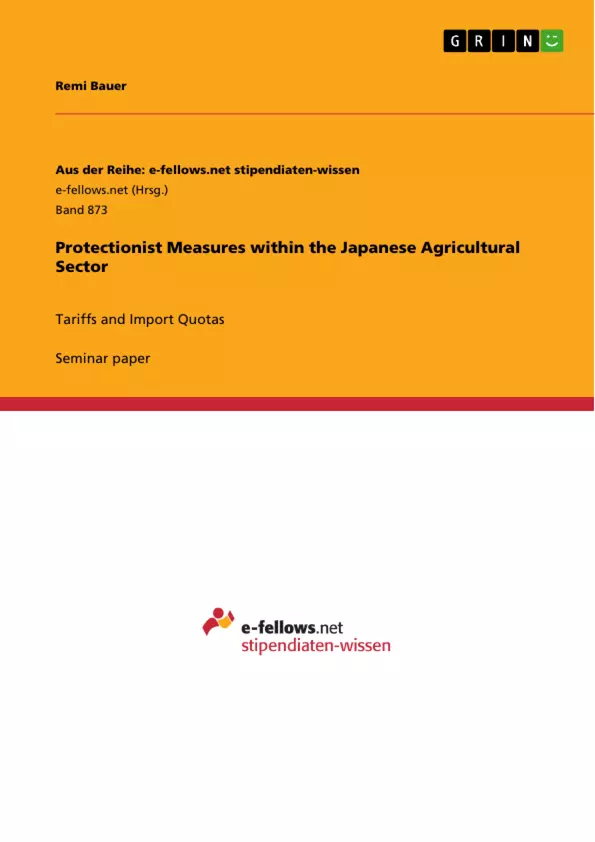In its latest White Paper on International Economy and Trade 2009, the Japanese Ministry of Economy, Trade and Industry listed prevention of protectionism as one of its courses for “Domestic and foreign integrated economic measures” (Ministry of Economy, Trade and Industry 2009). With 153 member states in the World Trade Organization, formerly known as General Agreement on Tariffs and Trade, which is a multilateral institution that liberalizes trade, establishes trade agreements and solves trade disputes, one might think that protectionism should not be a problem in the 21st century (Gabler Verlag 2009b). Japan joined the General Agreement on Tariffs and Trade in 1955 and is still a member of the World Trade Organization today. However, the government of this nation still feels the necessity to state deterrence of protectionist measures in a paper which was only published in June 2009 (World Trade Organization 2009a). Thus, the question arises how important is protectionism for Japan nowadays. This question will be answered by explaining protectionist measures and looking at the historical development of such measures in Japan since 1945 in the agricultural sector. The agricultural sector is interesting since Japan's agricultural imports accounted to over $50 billion in 2008. After the United States of America and the European Union, Japan is the third largest importer of agricultural goods. Based on total calories consumed, Japan imports about 60 per cent of its food sources annually (United States Department of Agriculture Economic Research Service 2009a). By evaluating official government sources, the current situation is assessed and the effects of protectionist measures on imports by focusing on the agricultural sector will be elaborated.
Inhaltsverzeichnis (Table of Contents)
- Introduction
- Protectionism
- Protectionist Measures
- Import Quotas
- Tariffs
- Japan and Protectionism
- Historic Development since 1945
- Development of Import Quotas
- Development of Tariffs
- Current Situation
- Milk Products
- Grains
- Historic Development since 1945
- Effects
- Importance of Protectionism for Japan
Zielsetzung und Themenschwerpunkte (Objectives and Key Themes)
This work aims to explore the importance of protectionist measures for Japan's agricultural sector in the 21st century. It examines the historical development of protectionist policies in Japan, analyzes the current situation, and evaluates the effects of these policies on imports. Key themes covered in this text include:- The concept of protectionism and its implications for domestic producers and the global economy.
- The role of protectionism in Japan's post-war economic recovery and its continued relevance in the agricultural sector.
- The effectiveness of specific protectionist measures, such as import quotas and tariffs, in safeguarding domestic industries.
- The impact of protectionism on Japan's agricultural imports and the broader food supply chain.
Zusammenfassung der Kapitel (Chapter Summaries)
- Introduction: This chapter introduces the topic of protectionism in Japan, highlighting the government's emphasis on preventing protectionist measures. It establishes the importance of the agricultural sector and its significant reliance on imports, setting the stage for the subsequent analysis.
- Protectionism: This chapter provides a theoretical framework for understanding protectionism by examining its effects on supply and demand, highlighting the potential disadvantages for domestic producers amidst international competition. It explains the rationale behind protectionist measures as a trade policy tool.
- Protectionist Measures: This chapter focuses on two key protectionist measures, import quotas and tariffs. It defines these measures, explains their mechanisms, and analyzes their impact on market equilibrium. This chapter also briefly explores the combined application of quotas and tariffs through tariff-rate quotas.
- Japan and Protectionism: This chapter delves into Japan's history of protectionism, specifically post-1945. It explores the influence of the Yoshida Doctrine on economic recovery and the role of protectionist measures in supporting domestic industries. The chapter emphasizes the development of import quotas and tariffs in Japan after its entry into the General Agreement on Tariffs and Trade (GATT) in 1955.
Schlüsselwörter (Keywords)
Protectionism, trade policy, agricultural sector, import quotas, tariffs, tariff-rate quotas, Japan, post-war economic recovery, Yoshida Doctrine, food supply chain, domestic producers, international trade, global economy.- Quote paper
- Remi Bauer (Author), 2009, Protectionist Measures within the Japanese Agricultural Sector, Munich, GRIN Verlag, https://www.grin.com/document/266435



